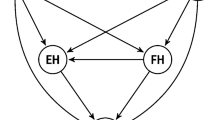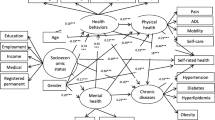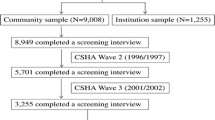Abstract
Self-Rated Health (SRH) is becoming one of the most popular indicator of population health. Nevertheless, a limited understanding still remains about the elements to which individuals refer when evaluating their health and how those elements act and interact in the evaluation process. In this study we use a structural equation model with latent variables to identify direct and indirect influences of various health dimensions (chronic morbidity, functional abilities and emotional health) and socio-demographic covariates (age, gender and education) on poor SRH. The sample consists of 25,183 Italian elderly aged 65 years and over, interviewed in the 2005 National Health Interview Survey. The results have pointed out the higher direct effect of psychological and emotional health on SRH, while the higher total effect is caused by chronic morbidity, which influences SRH both directly and altering functional and emotional health. Growing older, being a woman and having a low education negatively impacts on SRH. However, this is almost completely the result of the indirect effect exerted by the covariates, while their direct effect is not significant (gender), negative (age) or very modest (education).



Similar content being viewed by others
References
Albrecht, G. L., & Devlienger, P. J. (1999). The disability paradox: High quality of life against all odds. Social Science and Medicine, 48(8), 977–988.
Arnadottir, S. A., Gunnarsdottir, E. D., Stenlund, H., & Lundin-Olsson, L. (2011). Determinants of self-rated health in old age: A population based, cross sectional study using the International Classification of Functioning. BMC Public Health, 11, 670.
Au, N., & Johnston, D. W. (2014). Self-assessed health: What does it mean and what does it hide? Social Science and Medicine, 121, 21–28.
Averria Sirkin, M., Palmer, B. W., Rock, D., Gelston, C. V., & Jeste, D. V. (2014). Associations of self-perceived successful aging in young–old versus old–old adults. International Psychogeriatrics. doi:10.1017/S104161021400221X.
Bagozzi, R. P., & Yi, Y. (2012). Specification, evaluation, and interpretation of structural equation models. Journal of the Academy Marketing Science, 40, 8–34.
Baron-Epel, O., & Kaplan, G. (2001). General subjective health status or age-related subjective health status: Does it make a difference? Social Science and Medicine, 53, 1373–1381.
Benyamini, Y., Leventhal, E. A., & Leventhal, H. (2003). Elderly people’s rating of the importance of health-related factors to their self-assessments of health. Social Science and Medicine, 56, 1661–1667.
Berry, W. D. (1984). Nonrecursive causal models (p. 95). Beverly Hills, CA: Sage.
Borawski-Clark, E. A., Kinney, J. M., & Kahana, E. (1996). The meaning of older adults’ health appraisal: Congruence with health status and as determinant of mortality. Journal of Gerontology, 51b, S157–S170.
Cagney, K. A., Browning, C. R., & Wen, M. (2005). Racial disparities in self-rated health at older ages: What difference does the neighbourhood make? Journals of Gerontology. Series B, Psychological Sciences and Social Sciences, 60, S181–S190.
Chang-Quan, H., Xue-Mei, Z., Bi-Rong, D., Zhen-Chan, L., Ji-Rong, Y., & Quing-Xiu, L. (2010). Health status and risk for depression among elderly: A meta-analysis of published literature. Age and Ageing, 39, 23–30.
de Bruin, A., Picavet, H. S., & Nossikov A. (1996). Health interview surveys. Towards international Harmonization of methods and instruments, WHO Regional Publication. European Ser 58:161.
Delpierre, C., Lauwers-Cances, V., Datta, G. D., Lang, T., & Berkman, L. (2009). Using self-rated health for analysing inequalities in health: A risk for underestimating the gap between socioeconomic groups? Journal of Epidemiology and Community Health, 63, 426–432.
DeSalvo, K. B., Jones, T. M., Peabody, J., McDonald, J., Fihn, S., Fan, V., et al. (2009). Health Care expenditure prediction with a single item, self-rated health measure. Medical Care, 47, 440–447.
Egidi, V., & Spizzichino, D. (2006). Perceived health and mortality: a multidimensional analysis of ECHP Italian data. Genus, 3–4, 135–153.
Egidi, V., & Spizzichino, D. (2007). Dimensioni oggettive e soggettive delle differenze di genere nella salute. In A. Pinnelli, F. Racioppi, & L. Terzera (Eds.), Genere, famiglia e salute (pp. 560–581). Milano: Franco Angeli.
Fayers, P., & Sprangers, M. A. G. (2002). Understanding self-rated health. The Lancet, 359, 187–188.
Ferraro, K. (1980). Self-ratings of health among the old and the old–old. Journal of Health and Social Behavior, 21, 377–383.
French, D. J., Browing, C., Kendig, H., Luszcz, M. A., Saito, Y., Sargent-Cox, K., & Anstey, K. J. (2012a). A simple measure with complex determinants: investigation of the correlates of self-rated health in older men and women from three continents. BMC Public Health, 12, 649. doi:10.1186/1471-2458-12-649.
French, D. J., Sargent-Cox, K., & Luszcz, M. A. (2012b). Correlates of subjective health across the aging lifespan: understanding self-rated health in the oldest old. Journal of Aging and Health, 24, 1449–1469.
Fylkesnes, K. (1993). Determinants of health care utilization: Visits and referrals. Scandinavian Journal of Social Medicine, 21, 40–50.
Garrity, T. F., Somes, G. W., & Marx, M. B. (1978). Factors influencing self-assessment of health. Social Science and Medicine, 12, 77–81.
Gaumé, C., & Wunsch, G. (2010). Self-rated health in the Baltic Countries, 1994–1999. European Journal of Population, 26, 435–457.
Girón, P. (2010). Determinants of self-rated health in Spain: Differences by age groups for adults. European Journal of Public Health, 22, 36–40.
Han, B., & Jylhä, M. (2006). Improvements in depressive symptoms and changes in self-rated health among community-dwelling disabled older adults. Aging and Mental Health, 10, 599–605.
Hardy, M. A., Acciai, F., & Reyes, A. M. (2014). How health conditions translate into self-ratings. A comparative study of older adults across Europe. Journal of Health and Social Behavior, 55, 320–341.
Heller, D. A., Ahern, F. M., Pringle, K. E., & Brown, T. V. (2008). Among older adults, the responsiveness of self-rated health to changes in Charlson comorbidity was moderated by age and baseline comorbidity. Journal of Clinical Epidemiology, 62, 177–187.
Hirve, S., Oud, J. H. L., Sambhudas, S., Juvekar, S., Blomstedt, Y., Tollman, S., et al. (2014). Unpacking self-tated health and quality of life in older adults and elderly in India: A Structural Equation Modelling Approach. Social Indicators Research, 117, 105–119.
Hooper, D., Coughlan, J., & Mullen, M. R. (2008). Structural equation modelling: guidelines for determining model fit. The Electronic Journal of Business Research Methods, 6(1), 53–60.
Hudson, D. L., Puterman, E., Bibbings-Domingo, K., Matthews, K. A., & Adler, N. E. (2013). Race, life course socioeconomic position, racial discrimination, depressive symptoms and self-rated health. Social Science and Medicine, 97, 7–14.
Huisman, M., & Deeg, D. (2010). A commentary on Maria Jylhä’s “What is self-rated health and why does it predict mortality? Towards a unified conceptual model” (69:3, 2009, 307–316). Social Science and Medicine, 70, 652–654.
Idler, E. L., & Benyamini, Y. (1997). Self-rated health and mortality: A review of twenty-seven community studies. Journal of Health and Social Behavior, 38, 21–37.
Idler, E. L., Hudson, S. V., & Leventhal, H. (1999). The meaning of self-rating of health. A qualitative and quantitative approach. Research on Aging, 21, 440–457.
Idler, E. L., & Kasl, S. (1991). Health perceptions and survival: Do global evaluations of health status really predict mortality? Journal of Gerontology, Social Sciences, 46(2), S55–S65.
Jamoon, E. W., Johnson, W., Suzuki, R., Andresen, E. M., Campbell, V. A., & the RRTC Expert Panel on Health Status. (2008). Age at disability onset and the self-reported health status. BMC Public Health, 8, 10. doi:10.1186/1471-2458-8-10.
Johnson, R. J., & Wolinsky, F. (1993). The structure of health status among older adults: Disease, disability, functional limitation, and perceived health. Journal of Health and Social Behavior, 34(2), 105–121.
Jylhä, M. (2009). What is self-rated health and why does it predict mortality? Towards a unified conceptual model. Social Science and Medicine, 69, 307–316.
Jylhä, M., Guralnik, J. M., Balfour, J., & Fried, L. P. (2001). Walking difficulty, walking speed, and age as predictors of self-rated health: The Women’s Health and aging Study. Journals of Gerontology. Series A, Biological Sciences and Medical Sciences, 56(10), M609–M617.
Jylhä, M., Volpato, S., & Guralnik, J. A. (2006). Self-rated health showed a graded association with frequently used biomarkers in a large population sample. Journal of Clinical Epidemiology, 59(5), 465–471.
Kaplan, G., Barell, V., & Lusky, A. (1988). Subjective state of health and survival in elderly adults. Journal of Gerontology, Social Sciences, 43(4), S114–S120.
Kaplan, G., & Baron-Epel, O. (2003). What lies behind the subjective evaluation of health status? Social Science and Medicine, 56, 1669–1676.
Kasai, Y., Suzuki, E., Iwase, T., Doi, H., & Takao, S. (2013). Type D personality is associated with psychological distress and poor self-rated health among the elderly: A population based study in Japan. PLoS ONE. doi:10.1371/journal.pone.0077918.
Kawachi, I., & Berkman, L. F. (2000). Social cohesion, social capital, and health. In L. F. Berkman & I. Kawachi (Eds.), Social epidemiology (p. 416). Oxford: Oxford University Press.
Kline, R. B. (2010). Principles and practice of structural equation modelling (3rd ed., p. 430). New York, NY: The Guilford Press.
Krause, N. M., & Jay, G. M. (1994). What do global self-rated health items measure? Medical Care, 32(9), 930–942.
Kupek, E. (2006). Beyond logistic regression: structural equation modelling for binary variables and its application to investigating unobserved confounders. BMC Medical Research Methodology. doi:10.1186/1471-2288-6-13.
Liang, J. (1986). Self-rated physical health among aged adults. Journal of Gerontology, 41, 248–260.
Liang, J., Bennett, J., Whitelaw, N., & Maeda, D. (1991). The structure of self-reported physical health among the aged in the United States and Japan. Medical Care, 29(12), 1161–1180.
Long, J. S. (1997). Regression models for categorical and limited dependent variables. Thousand Oaks, CA: Sage.
Luppa, M., Luck, T., Weyerer, S., Köning, H. H., Brähler, E., & Riedel-Heller, S. G. (2010). Prediction of institutionalization in the elderly. A systematic review. Age and Ageing, 39, 31–38.
Mackenbach, J. P., Simon, J. G., Looman, C. W. N., & Joung, I. M. A. (2002). Self-assessed health and mortality: Could psychological factors explain the association? International Journal of Epidemiology, 31, 1162–1168.
Maddox, G. (1962). Some correlates of differences in self-assessment of health among the elderly. Journal of Gerontology, 17, 180–185.
Malmusi, D., Artazcoz, L., Benach, V. (2012). Perception or real illness? How chronic conditions contribute to gender inequalities in self-rated health. The European Journal of Public Health, 6, 781–786.
Manderbacka, K., Lundberg, O., & Martikainen, P. (1999). Do risk factors and health behaviours contribute to self-ratings of health? Social Science and Medicine, 481(12), 1713–1720.
Mantzavinis, G. D., Pappas, N., Dimoliatis, I. D. K., & Ioannidis, J. P. A. (2005). Multivariate models of self-reported health often neglected essential candidate determinants and methodological issues. Journal of Clinical Epidemiology, 58, 436–443.
Mavaddatt, N., Kinmonth, A. L., Sanderson, S., Surtees, P., Bingham, S., & Khaw, K. T. (2011). What determines self-rated health (SRH)? A cross-sectional study of SF36 health domains in the Epic-Norfolk cohort. Journal of Epidemiology and Community Health, 56, 800–806.
Menec, V. H., Shooshtari, S., & Lambert, P. (2007). Ethnic differences in self-rated health among older adults: A cross-sectional and longitudinal analysis. Journal of Aging and Health, 19, 62–86.
Mossey, J. M., & Shapiro, E. (1982). Self-rated health: A predictor of mortality among the elderly. American Journal of Public Health, 72(8), 800–808.
Mulsant, B. H., Ganguli, M., & Seaberg, E. C. (1997). The relationship between self-rated health and depressive symptoms in an epidemiological sample of community dwelling older adults. Journal of the American Geriatrics Society, 45(8), 954–958.
Muthén, B. O. (1983). Latent variable structural equation modeling with categorical data. Journal of Econometrics, 22, 48–65.
Muthén, B. O. (2002). Beyond SEM: General latent modelling. Behaviometrika, 29, 81–117.
Muthén, L. K., & Muthén, B. O. (2012). Mplus user’s guide (7th ed., p. 856). Los Angeles, CA: Muthén and Muthén.
Nagi, S. (1965). Some conceptual issues in disability and rehabilitation. In M. B. Sussman (Ed.), Sociology and rehabilitation (pp. 100–113). Washington, DC: American Sociological Association.
Nummela, O., Seppänen, M., & Uutela, A. (2011). The effect of loneliness and change in loneliness on self-rated health (SRH): A longitudinal study among aging people. Archives of Gerontology and Geriatrics, 53, 163–167.
Ongaro, F., & Salvini, S. (1995). Understanding self-perceived health in the elderly. European Journal of Population, 11, 123–141.
Orfila, F., Ferrer, M., Lamarca, R., Tebe, C., Domingo-Salvany, A., & Alonso, J. (2006). Gender differences in health-related quality of life among the elderly: The role of objective functional capacity and chronic conditions. Social Science and Medicine, 63, 2367–2380.
Perruccio, A. V., Katz, J. N., & Losina, E. (2012). Health burden in chronic disease: Multimorbidity is associated with self-rated health more than medical comorbidity alone. Journal of Clinical Epidemiology, 65, 100–106.
Ross, E., & Mirowsky, J. (1984). Socially-desirable response and acquiescence in a cross-cultural survey of mental health. Journal of Health and Social Behavior, 25, 189–197.
Schulz, R., Heckhausen, J., & O’Brien, A. (2013). Negative affect and the disablement process in late life. In S. B. Manuk, R. Jennings, B. Rabin, & A. Baum (Eds.), Behavior, Health an Aging (pp. 119–134). NY: Psychology Press.
Schütte, S., Chastang, J. F., Parent-Thirion, A., Vermeylen, G., & Neidhammer, I. (2013). Association between socio-demographic, psychosocial, material and occupational factors and self-reported health among workers in Europe. Journal of Public Health. doi:10.1093/pubmed/fdt050.
Schüz, B., Wurm, S., Schöllgen, I., & Tesch-Römer, C. (2011). What do people include when they self-rate their health? Differential associations according to health status in community-dwelling older adults. Quality of Life Research, 20, 1573–1580.
Segerstrom, S. (2014). Affect and self-rated health. A dynamic approach with older adults. Health Psychology, 33, 720–728.
Sen, A. (2002). Health perception versus observation. Self- reported morbidity has severe limitation and can be extremely misleading. British Medical Journal, 324, 860–861.
Simon, J. G., De Boer, J. B., Joung, I. M. A., & Mackenbach, J. P. (2005). How is your health in general? A qualitative study on self-assessed health. European Journal of Public Health, 15, 200–208.
Singh-Manoux, A., Martikainen, P., Ferrie, J., Zins, M., Marmot, M., & Goldberg, M. (2006). What does self-rated health measure? Results from the British Whitehall II and French Gazel cohort studies. Journal of Epidemiology and Community Health, 60, 364–372.
Verroupoulou, G. (2009). Key elements composing self-rated health in older adults: a comparative study of 11. European Countries. European Journal of Ageing, 6, 213–226.
Ware, J. E., Kosinski, M., & Gandek, B. (1993). SF-36 health survey: Manual and interpretation guide. Boston, MA: The Health Institute, New England Medical Center.
Ware, J. E., Kosinski, M., & Keller, S. D. (1996). A 12-item short-form health survey. Construction of scales and preliminary tests of reliability and validity. Medical Care, 34, 220–233.
Watson, D., & Pennebaker, J. W. (1989). Health complaints, stress, and distress: Exploring the central role of negative affectivity. Psychological Review, 96, 234–254.
Whitehead, B. R., & Bergerman, C. S. (2013). Self-reported health bias: The role of daily affective valence and arousal. Psychological Health, 28, 784–799.
Whitelaw, N. A., & Liang, J. (1991). The structure of the OARS. Physical Health Measures, 29(4), 332–347.
Yu, C. Y., & Muthén, B. O. (2002). Evaluation of model fit indices for latent variable models with categorical and continuous outcomes (Technical report). University of California, Los Angeles, Graduate School of Education and Information Studies; Los Angeles.
Author information
Authors and Affiliations
Corresponding author
Rights and permissions
About this article
Cite this article
Golini, N., Egidi, V. The Latent Dimensions of Poor Self-Rated Health: How Chronic Diseases, Functional and Emotional Dimensions Interact Influencing Self-Rated Health in Italian Elderly. Soc Indic Res 128, 321–339 (2016). https://doi.org/10.1007/s11205-015-1033-3
Accepted:
Published:
Issue Date:
DOI: https://doi.org/10.1007/s11205-015-1033-3




